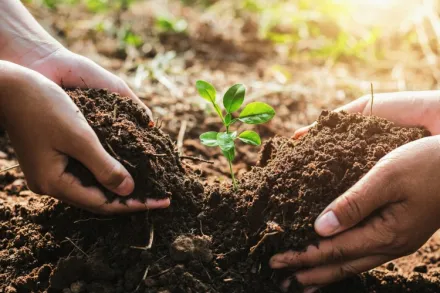Deterioration of Land Quality:
The United Nations celebrated 2015 as the ‘World Soil Year’ and designated 2015-2024 as the ‘International Decade of Soils.’ India, with the 10th largest cultivable land resource globally, hosts 46 out of 60 soil types found worldwide. National and international agencies predict a future decline in cultivable land and soil fertility as a significant issue.
Key Issues in Soil Quality Decline
In regions like Punjab, Western Uttar Pradesh, and Haryana, intensive cropping systems and improper agricultural practices have led to soil exploitation and quality degradation over several decades. Faulty practices adversely impact soil fertility and productivity, compounded by farmers’ lack of knowledge and inadequate agricultural extension services.

Challenges Facing Soil Protection
- Lack of soil testing centers
- Decrease in organic fertilizer use
- Imbalanced nutrient use
- Faulty irrigation systems and poor quality irrigation water
- Formation of hard layers beneath the soil surface
- Salinity issues
- Improper and excessive soil exploitation
- Agricultural land degradation
- Increasing weed infestation
- Soil erosion
United Nations: Sustainable Development Goals (SDGs)
India, along with other nations, signed the declaration for the 2030 Agenda for Global Sustainable Development at the United Nations Conference on Sustainable Development. The agenda includes 17 SDGs aimed at achieving a ‘hunger-free world’ by 2030, necessitating:
- Food Security
- Nutritional Security
- Soil Protection
- Livelihood Security
- Environmental Security
- Biodiversity Conservation
United Nations Initiatives in Soil Management
United Nations Convention to Combat Desertification (UNCCD): A legally binding framework to address desertification and drought, supported by international cooperation. The first conference was in Rome (1997), and the 16th will be in Riyadh (2024).
Intergovernmental Panel on Climate Change (IPCC): The IPCC reports that 23% of global arable land and 30% of India’s land have eroded. Addressing this requires changes in farming practices, not just reducing carbon emissions. India aims to cultivate 26 million hectares of barren land by 2030, up from 21 million.
Environment-Friendly Technologies for Soil Conservation
Development of Nano Fertilizers: IFFCO’s Nano Biotechnology Research Center has developed ‘Nano Nutrients’ like Nano Zinc, Nano Nitrogen, and Nano Copper. These cost 50% less and can boost crop productivity by 15-30%, improving soil health and reducing greenhouse gas emissions.
Promoting Agroforestry: This land management method integrates trees and shrubs with crops and livestock, enhancing soil fertility, meeting ecological needs, and increasing food, fodder, fuel, fruit, vegetable, and wood production. The “Tree on every Medh” program under the Agro Forestry Mission supports additional farmer income and soil conservation.
Increasing Awareness of Coarse Grains: Historically cultivated in India, coarse grains like kodo, kutki, sawa, kakun, jawa, and johri are high in fiber and water-efficient, needing less irrigation and thriving on less fertile land. Promoting these grains supports diversified farming and soil fertility.
Crop Diversification: Diversifying crops protects soil health, supports sustainable agriculture, and reduces pests and diseases. It also ensures rural employment and better economic returns, making agriculture more profitable and ecologically beneficial.
Soil Health Initiatives
Development of Pusa S.T.F.R. Meter: Aiming for ‘Healthy Earth, Green Fields,’ the Central Government’s Soil Health Card scheme provides detailed soil parameters and fertilizer recommendations through the Soil Test Fertilizer Recommendation Meter, determining 14 soil parameters.
Development of Compost Vaccine: Pusa Decomposer, a microorganism group, rapidly decomposes crop residues and organic matter, promoting effective agricultural waste management.
Development of Liquid Organic Fertilizers: The Indian Agricultural Research Institute, New Delhi, produces long-lasting, high-bacteria liquid organic fertilizers used for seed, root, and soil treatment.
Production of 100% Neem Coated Urea: This reduces nitrogen leaching and denitrification, increases nitrogen use efficiency, and decreases crop pests, diseases, and greenhouse gas emissions.
Emphasis on Natural and Organic Farming: A policy promoting organic, natural, and integrated farming aims to reduce chemical fertilizer usage. An online national market for organic products is being strengthened, helping farmers earn more while curbing excessive chemical use.
Integrated Nutrient Management Techniques (INM): INM techniques, involving the use of all nutrient sources alongside chemical fertilizers, promote sustainable crop production. Sources include cow dung manure, compost, green manure, poultry manure, vermicompost, crop residue management, and organic fertilizers.
Conclusion
Soil is a crucial natural resource. Regions that achieved the Green Revolution now face challenges in maintaining crop production levels and soil quality. Addressing these challenges requires soil restoration and fertility management. With increasing industrialization and urbanization reducing natural resources, enhancing production per unit area through proper soil management is essential to meet the growing population’s food needs.
Disclaimer
The content provided on studyhub.net.in is intended for informational and educational purposes, designed to support students and professionals preparing for competitive exams, including UPSC GSI, CSIR NET, GATE Geology and Geophysics, and GATE 2025. All articles, study guides, and materials are carefully curated from highly recommended books and reputable sources to serve as an additional resource for students preparing for these exams.
If any content is found to infringe on copyright, please reach out to us at pdpal9@gmail.com. We are committed to respecting intellectual property rights and will address any issues promptly.
Thank you for choosing studyhub.net.in as part of your educational journey.
Please note that StudyHub.net.in is not responsible for any errors or omissions, nor for any losses or damages arising from the use of this information. For official, verified details, users are advised to refer to authoritative sources and government publications.